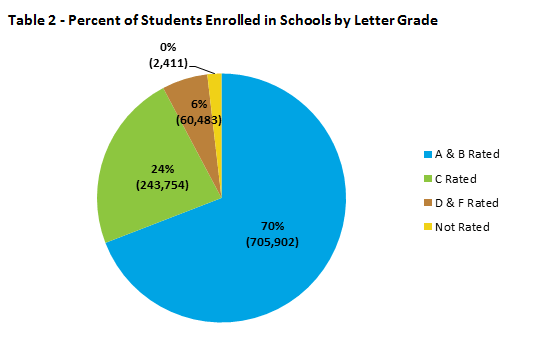School finance has been the topic of lively debate in Arizona, recently. Parents, school leaders, and politicians from both political parties have openly expressed their concern over years of budget cuts, while newspapers continue to report school funding as a major concern of educators, expressed at the Superintendent’s “We Are Listening” tour. Add to that a recent report by the U.S. Census Bureau that ranks Arizona at or near the bottom in per pupil spending, and it’s clear that school funding is an issue that needs to be addressed.
Although recent discussions about school funding would make it seem that urgent reform is needed, data reported from the Arizona Department of Education earlier this year paints a different picture. Every year, the Department assigns letter grades to public schools based on a combination of their students’ performance on standardized tests and academic growth. Although these grades are not perfect measures of school quality, they offer insight into how a school is serving its students. When school letter grades were released to the public last August, education advocates were pleased to announce that schools were not only doing well, but that they had improved from the previous year. Our analysis showed that that 61 percent of public schools received an A or B rating and that nearly 70 percent of public school students attended an A or B rated school. Looking at these statistics, it seems that Arizona’s public schools are doing quite well.
Taken together, the fact that Arizona ranks at or near the bottom in per pupil spending at the same time it enrolls 70 percent of its students in A and B rated schools may be seen as an argument against increasing school funding. In fact, these data could be interpreted to indicate that perhaps Arizona public schools are fine just the way they are.
We believe, however, that this is not the case. As we’ve written previously, Arizona’s school letter grades are not reflective of the true state of education in Arizona. This is problematic for school funding and education reform advocates because, by our state’s own measures, Arizona schools appear to be doing well despite years of budget cuts. However, consider the fact that in 2013, Arizona ranked 42nd in fourth-grade reading scores and 22nd in fourth-grade math scores on the National Assessment of Educational Progress. Also, roughly 44 percent of high school graduates do not enroll in post-secondary institutions upon graduation and only 19 percent receive a diploma from a four-year institution six years after graduating from high school. These data surely paint a very different picture of school performance. It is plausible to assume that in order for Arizona to improve on these external measures of student performance, schools will need additional resources. As the old adage states: the definition of insanity is doing the same thing over again and expecting a different result.
So then, if we believe that our schools are likely to require more resources then we must be clear about student outcomes. This is not to diminish the work of teachers, principals, and students at A and B rated schools. Earning these labels requires significant effort and should be commended. However, we must also acknowledge that earning an A or B, in a system that essentially norms public school performance, does not mean that students are college and career ready. If Arizona students are to receive the education that they deserve, then we must do more to provide them with access to rigorous curricula, excellent teachers, and resources that will prepare them to be happy and productive citizens in the 21st Century. Doing this, however, costs money.
In the coming months, policy makers, educators and business leaders plan to address some of the state’s most pressing education issues. The Governor’s Classrooms First Initiative Council is faced with the daunting task of school finance reform. At the same time, the Arizona State Board of Education and the Department of Education will begin redesigning A-F letter grades.
The Association will play an active role as technical advisors on both issues. As we advocate for increased funding for students, we will also be clear to decision makers that Arizona students deserve better schools.





